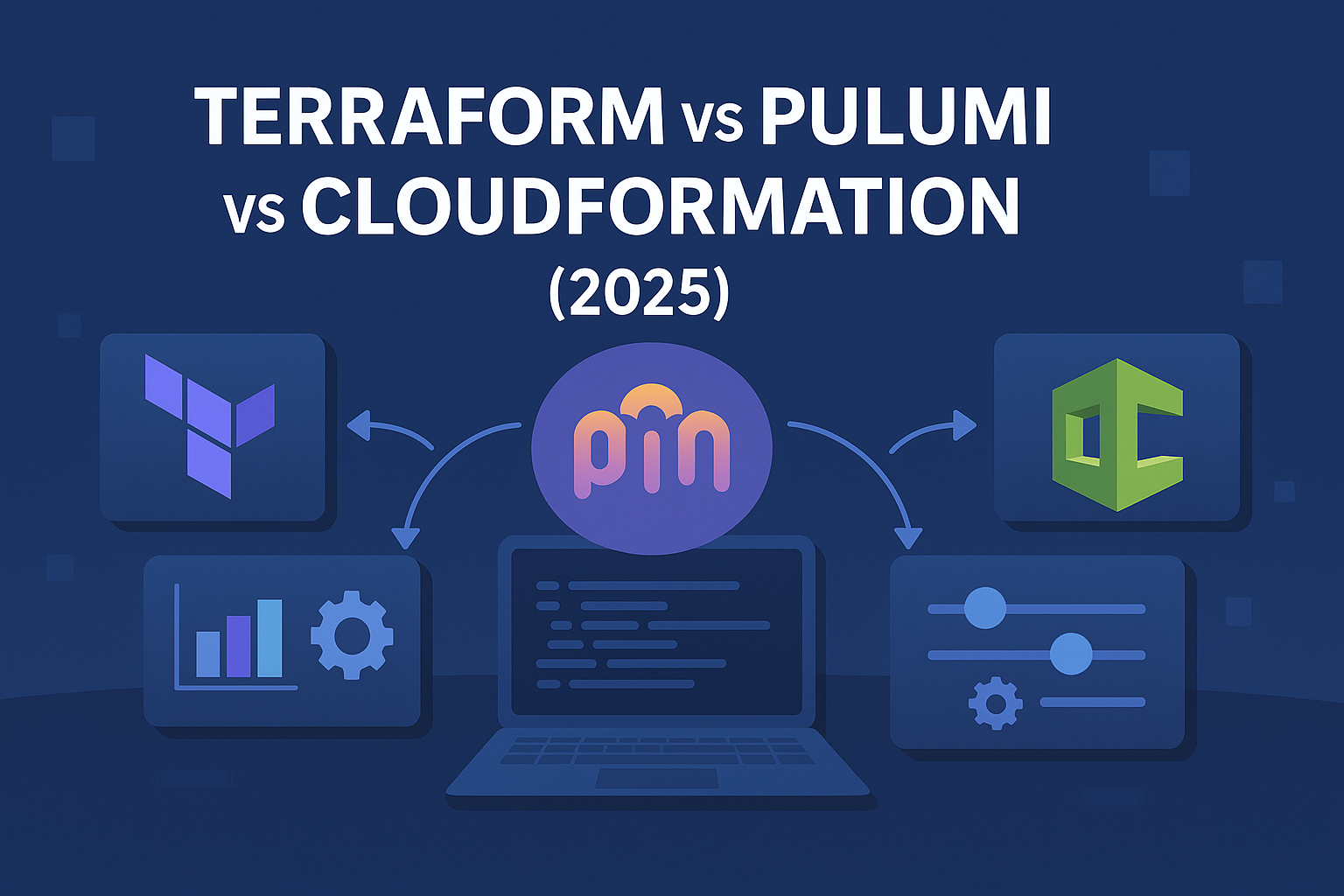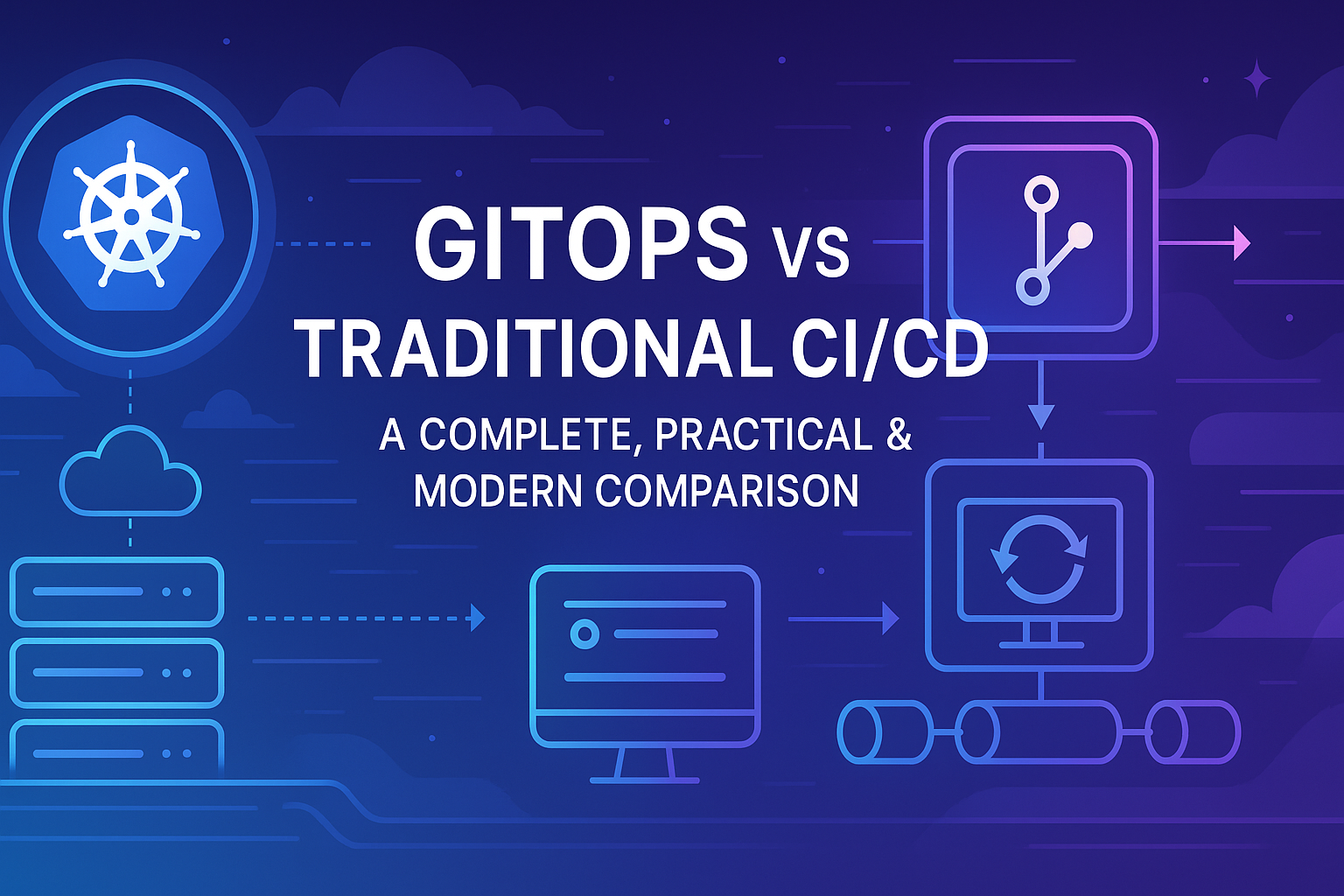Terraform vs Pulumi vs CloudFormation (2025): The Ultimate Infrastructure-as-Code Showdown
*By DevOps Enginer – Infrastructure as Code Series* *Published: November 2025*
Introduction: The IaC Landscape in 2025
Infrastructure as Code (IaC) has matured massively over the last decade. In 2025, engineering teams have three dominant choices for building, managing, and scaling cloud infrastructure:
✅ Terraform (HashiCorp) ✅ Pulumi (Modern, TypeScript/Python-powered IaC) ✅ AWS CloudFormation (AWS-native declarative IaC)
Each has strengths, weaknesses, and unique architectural differences. This guide provides a complete, modern, deeply practical comparison—backed by real use cases, performance considerations, and cloud best practices used by DevOps teams globally.
🌍 Why IaC Matters Even More in 2025
Cloud infrastructure today is:
- Multi-cloud
- Microservices-driven
- Kubernetes-native
- Automated and event-driven
- Security-first (shift-left DevSecOps)
- Cost-optimized (FinOps integrated IaC)
Organizations expect:
✔ Zero manual changes ✔ Reproducible environments ✔ Full Git audit trails ✔ Automated governance ✔ Policy-as-code ✔ AI-assisted infrastructure workflows
IaC is no longer optional — it's the backbone of modern DevOps.
🔥 Quick Summary Table (2025)
| Feature | Terraform | Pulumi | CloudFormation |
|---|---|---|---|
| Language | HCL | TypeScript, Python, Go, C# | YAML/JSON |
| Multi-cloud support | ⭐⭐⭐⭐⭐ | ⭐⭐⭐⭐⭐ | ⭐ |
| Ecosystem size | Largest | Growing fast | AWS-only |
| Learning curve | Medium | Low/Medium | High (verbose) |
| AI-integration | Medium | High | Low |
| Speed | Moderate | Fast | Slow |
| Best for | Enterprise, multi-cloud | Developers, modern teams | AWS-exclusive teams |
🧩 1. Terraform (HashiCorp) — The IaC King in 2025
Terraform remains the most popular IaC tool globally due to:
✔ Multi-cloud support ✔ A massive community ✔ Battle-tested reliability ✔ Thousands of modules ✔ A neutral declarative format (HCL)
Even after HashiCorp's 2023 licensing shift, Terraform forks like OpenTofu kept the ecosystem thriving.
### 🔧 Terraform Pros
#### 1. True Multi-Cloud Powerhouse
Works across:
- AWS
- GCP
- Azure
- Alibaba Cloud
- Oracle Cloud
- VMWare
- GitHub
- Cloudflare
- And 300+ providers
No other IaC tool supports this many integrations.
#### 2. Mature Ecosystem
Terraform Registry is the largest IaC ecosystem in the world.
#### 3. Predictable, declarative workflow
Plan → Apply → DestroyClear, auditable, and stable.
#### 4. Best for large teams
Terraform Cloud/Enterprise offers:
- Remote state
- RBAC
- Drift detection
- Policy-as-code
- Team workflows
### ❌ Terraform Cons
- HCL can feel limited for complex logic
- State files require careful management
- Dependency graph errors can appear
- Slower compared to Pulumi for large stacks
### 🧪 Terraform Example
resource "aws_s3_bucket" "example" {
bucket = "myapp-bucket"
acl = "private"
}
resource "aws_s3_bucket_versioning" "example" {
bucket = aws_s3_bucket.example.id
versioning_configuration {
status = "Enabled"
}
}
output "bucket_name" {
value = aws_s3_bucket.example.bucket
}🧩 2. Pulumi — The Modern IaC Option for Developers (2025)
Pulumi is the fastest-growing IaC tool in 2025 because it allows writing infrastructure using real programming languages:
- TypeScript / JavaScript
- Python
- C#
- Go
- Java
No YAML. No HCL. No DSL.
### 🔧 Pulumi Pros
#### 1. Full programming power
You get:
- Loops
- Functions
- Classes
- Conditionals
- Strong typing
- Object-oriented models
This makes Pulumi perfect for complex cloud architectures.
#### 2. AI-Native IaC
Pulumi has:
- AI-assisted IaC generation
- AI autocompletion
- Code-to-infrastructure guidance
Developers love this.
#### 3. Multi-cloud support
Like Terraform, Pulumi supports:
- AWS
- Azure
- GCP
- Kubernetes
- Cloudflare
- 80+ providers
#### 4. Great for Kubernetes
Pulumi can manage:
- Manifests
- Helm charts
- Controllers
- Operators
All using real programming logic.
### ❌ Pulumi Cons
- Requires programming skills
- Not ideal for simple infra
- Fewer pre-built modules than Terraform
- State stored in Pulumi Service (unless self-hosted)
### 🧪 Pulumi Example (TypeScript)
import * as aws from "@pulumi/aws";
const bucket = new aws.s3.Bucket("my-bucket", {
acl: "private",
versioning: {
enabled: true,
},
tags: {
Environment: "Production",
ManagedBy: "Pulumi",
},
});
export const bucketName = bucket.id;🧩 3. AWS CloudFormation — The AWS Native IaC Workhorse
CloudFormation is AWS's official IaC solution.
It is:
✔ Deeply integrated ✔ Secure by default ✔ Stable ✔ Battle-tested
But also:
❌ Extremely verbose ❌ Slow ❌ AWS-only
### 🔧 CloudFormation Pros
#### 1. 100% AWS-native
Best integration with:
- IAM
- Lambda
- ECS/EKS
- VPC
- RDS
- CloudWatch
- Secrets Manager
- Step Functions
#### 2. Ideal for enterprise compliance
Many regulated industries rely on it.
#### 3. Free
No additional cost (unlike some Terraform/Pulumi features).
#### 4. AWS CDK Integration
You can use AWS CDK (Cloud Development Kit) to write CloudFormation in TypeScript/Python, then compile to templates.
### ❌ CloudFormation Cons
- No multi-cloud
- YAML is huge and repetitive
- Very slow deployments
- Poor error messages
- Hard to modularize
### 🧪 CloudFormation Example
AWSTemplateFormatVersion: '2010-09-09'
Description: S3 Bucket with versioning
Resources:
MyS3Bucket:
Type: AWS::S3::Bucket
Properties:
BucketName: my-bucket
VersioningConfiguration:
Status: Enabled
Tags:
- Key: Environment
Value: Production
Outputs:
BucketName:
Description: Name of the S3 bucket
Value: !Ref MyS3Bucket🆚 Head-to-Head Comparison (2025)
### Speed
| Rank | Tool | Notes |
|---|---|---|
| 1 | Pulumi | Fastest execution |
| 2 | Terraform | Medium |
| 3 | CloudFormation | Slowest |
### Learning Curve
| Rank | Tool | Notes |
|---|---|---|
| 1 | Pulumi | Easy if dev-heavy team |
| 2 | Terraform | Moderate |
| 3 | CloudFormation | Hard & verbose |
### Multi-Cloud
Pulumi = Terraform > CloudFormation
### Kubernetes Support
Pulumi > Terraform > CloudFormation
### Enterprise Governance
Terraform Cloud > CloudFormation > Pulumi
🎯 Which IaC Tool Should You Use in 2025?
### Choose Terraform if:
✔ You need multi-cloud ✔ You want hundreds of modules ✔ You work with large teams ✔ You use Terraform Cloud or OpenTofu
### Choose Pulumi if:
✔ Your team is developer-heavy ✔ You want real programming languages ✔ You want the fastest IaC adoption ✔ You want AI-assisted IaC
### Choose CloudFormation if:
✔ You are 100% AWS-only ✔ You need compliance & audit-ready deployments ✔ You want deep AWS integration ✔ You use CDK (which compiles into CFN)
🏆 Final Verdict (2025)
| Category | Winner |
|---|---|
| Best Overall | Terraform |
| Best for Developers | Pulumi |
| Best for AWS Enterprises | CloudFormation / CDK |
| Best for Startups | Pulumi |
| Best for Multi-Cloud Enterprises | Terraform/OpenTofu |
📊 Real-World Use Cases
### Scenario 1: Startup Building Multi-Cloud SaaS
Recommendation: Pulumi
- Fast development
- TypeScript familiarity
- Easy Kubernetes integration
- AI-assisted workflows
### Scenario 2: Large Enterprise with AWS + Azure + GCP
Recommendation: Terraform
- Mature modules
- Strong governance
- Team collaboration features
- Proven at scale
### Scenario 3: AWS-Only Financial Institution
Recommendation: CloudFormation + CDK
- Regulatory compliance
- Deep AWS integration
- Audit trails
- Security best practices baked in
### Scenario 4: Platform Engineering Team
Recommendation: Terraform + Pulumi hybrid
- Terraform for base infrastructure
- Pulumi for application-level resources
- Best of both worlds
🔮 Future Trends (2026 and Beyond)
### AI-Generated Infrastructure
Both Terraform and Pulumi are integrating AI:
- Natural language → Infrastructure code
- Auto-optimization suggestions
- Security vulnerability detection
- Cost optimization recommendations
### Policy-as-Code Evolution
Expect more:
- OPA (Open Policy Agent) integration
- Automated compliance checks
- FinOps policies
- Security posture validation
### State Management Innovation
- Distributed state backends
- Blockchain-based state tracking
- Auto-healing state conflicts
📌 Conclusion
Terraform remains the most universal IaC tool. Pulumi is the most modern and fastest option. CloudFormation is the most AWS-integrated but outdated for complex workflows.
Your choice depends entirely on:
- Team size
- Cloud provider(s)
- Compliance needs
- Programming skills
- Deployment scale
- Multi-cloud requirements
In 2025, most organizations adopt:
Pulumi (dev teams) + Terraform/OpenTofu (platform teams)
CloudFormation remains relevant for AWS-only enterprises.
Frequently Asked Questions (FAQs)
QCan I migrate from Terraform to Pulumi?
Yes, Pulumi has a tf2pulumi converter that translates Terraform HCL to Pulumi code.
QIs OpenTofu better than Terraform?
OpenTofu is open-source and community-driven, making it ideal for avoiding vendor lock-in while maintaining compatibility.
QDoes Pulumi support all AWS services?
Yes, Pulumi supports all AWS services through its AWS provider.
QWhich is more secure?
All three are secure when configured correctly. CloudFormation has the advantage of being AWS-native with built-in IAM integration.
QWhat about AWS CDK?
AWS CDK compiles to CloudFormation templates, giving you programming language benefits while using CloudFormation under the hood.
About the Author
Rabin Adhikari — DevOps engineer and founder of DevOps Enginer.
Specializes in Infrastructure as Code, multi-cloud architecture, and platform engineering. Rabin writes practical guides that help teams choose the right tools and build scalable infrastructure.



